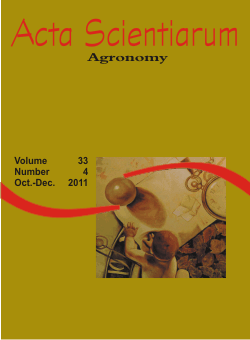<b>Mathematical modeling and simulation of hourly precipitation through rectangular pulses</b> - doi: 10.4025/actasciagron.v33i4.7052
Resumo
The recorded historical series of precipitation are usually available for short periods of time and with many failures. The use of mathematical modeling to simulate rainfall is a tool used to circumvent this problem and to simulate the operation of water systems in different scenarios. The present study applies mathematical modeling to the hourly pluviometric precipitation data simulation. A pluviographical data set from October 1980 to December 2007 was used in the study. Precipitation data sets were obtained through daily pluviometric digitalization from the Meteorologic Station of Epagri at Urussanga, in southern Santa Catarina, Brazil (latitude 28º 31’ S and longitude 48º 19’ W). To simulate the hourly rain series, the stochastic model was modified based on the Bartlett-Lewis rectangular pulses model with six parameters. Those parameters were fitted by minimizing a function related to the analytical expressions that define the average, variance, and autocorrelation coefficient at lag 1 and the probability of a dry period related to the estimated values from the observed data. Ten series were simulated for 100 years of data. Data analyses and results showed that fitting Bartlett-Lewis model parameters makes it possible to simulate hourly rainfall while preserving precipitation statistical properties at several temporal aggregation levels. In general, the probability of dry periods tended to be overestimated.Downloads
DECLARAÇÃO DE ORIGINALIDADE E DIREITOS AUTORAIS
Declaro que o presente artigo é original, não tendo sido submetido à publicação em qualquer outro periódico nacional ou internacional, quer seja em parte ou em sua totalidade.
Os direitos autorais pertencem exclusivamente aos autores. Os direitos de licenciamento utilizados pelo periódico é a licença Creative Commons Attribution 4.0 (CC BY 4.0): são permitidos o compartilhamento (cópia e distribuição do material em qualqer meio ou formato) e adaptação (remix, transformação e criação de material a partir do conteúdo assim licenciado para quaisquer fins, inclusive comerciais.
Recomenda-se a leitura desse link para maiores informações sobre o tema: fornecimento de créditos e referências de forma correta, entre outros detalhes cruciais para uso adequado do material licenciado.




















































